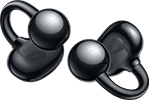Tässä lontooksi hieman jorinaa noista "neropateista":
Karl Gothe Jansky (1905-1949) was an American radio engineer who pioneered and developed radio astronomy. In 1932, he detected the first radio waves from a cosmic source - in the central region of the Milky Way Galaxy.
-----------------------------------
Nikola Tesla (1856-1943) was a Serbian-American inventor who developed the radio, fluorescent lights, the Tesla coil (an air-core transformer that generates a huge voltage from high-frequency alternating current), remote-control devices, and many other inventions; Tesla held 111 patents. Tesla developed and promoted the uses of alternating current (as opposed to direct current, which was promoted fiercely by Thomas Edison and General Electric). Tesla briefly worked with Thomas Edison. The unit of magnetic induction is named for Tesla; a tesla (abbreviated T) is equal to one weber per square meter. The radio was invented by Nikola Tesla. The radio was promoted and popularized by Guglielmo Marconi in 1895. The first radio transmission across an ocean (the Atlantic Ocean) occurred on December 12, 1901.
-----------------------------------
Guglielmo Marconi (1874-1937) was an Italian inventor and physicist. In 1895, Marconi promoted and popularized the radio (wireless telegraphy), building machinery to transmit and receive radio waves. His first transmission across an ocean (the Atlantic Ocean) was on December 12, 1901. Marconi won the Nobel Prize for physics in 1909.
-----------------------------------
James Clerk Maxwell (1831-1879). In the early nineteenth century, despite many individual advances in knowledge, there was no inkling of a comprehensive theory of electricity and magnetism. In developing this, Maxwell pointed the way to the existence of the spectrum of electromagnetic radiation. Defining fields as a tension in the medium, he stated his belief in a new concept - that energies resides in fields as well as bodies. This pointed the way to the application of electromagnetic radiation for such present-day uses as radio, television, radar, microwaves and thermal imaging.
-----------------------------------
...ja vielä puhelimeista ja aseista:
Alexander Graham Bell (March 3, 1847, Edinburgh, Scotland - August 2, 1922, Baddek, Nova Scotia) invented the telephone (with Thomas Watson) in 1876. Bell also improved Thomas Edison's phonograph. Bell invented the multiple telegraph (1875), the hydroairplane, the photo-sensitive selenium cell (the photophone, a wireless phone, developed with Sumner Tainter), and new techniques for teaching the deaf to speak.
Ask who really invented the telephone, and you may get the name of a German, Philipp Reis, not Alexander Graham Bell. The common wisdom is that Reis's telephone was only marginal, while Bell's phone really worked. Reis was a 26-year-old science teacher when he began work on the telephone in 1860. His essential idea came from a paper by a French investigator named Bourseul.
Only one part of Bourseul's idea was shaky. To send sound, the first diaphragm shouldn't make or break contact. It should vary the flow of electricity to the second diaphragm continuously. Reis used Bourseul's term, "make or break," but his diaphragm actually drove a thin rod to varying depths in an electric coil. He didn't make and or break the current. He varied it continuously.
Bell faced the same problem when he began work on his telephone a decade later. First, he used a diaphragm-driven needle, entering a water/acid solution, to create a continuously variable resistance and a smoothly varying electrical current. Bell got that idea from another American inventor, Elisha Gray.
Of course evaporation and immobility both make a liquid pool impractical. Bell soon gave it up in favor of a system closer to Reis's electromagnet. Still, it's clear that Gray's variable resistance pool had pointed the way for Bell. And so we wonder, was Bell also influenced by Reis's invention? Reis died two years before Bell received his patent. He was only 40, and he never did get around to seeking a patent for his device.
Still, we don't want to deny Bell's brilliance. He produced a robust and viable telephone, and he had the force of personality to sell it to a skeptical public. But to do that, he did what all inventors do. He built on the combined wisdom of others -- just as Reis had built on the work of Bourseul before him.
The very word priority cheats all but one person of credit. In fact, we must thank Bourseul, Reis, Gray, Bell -- all of them. For great inventions are always the gift of many people, not just one.
-----------------------------------
Samuel Colt invented the first revolver - named after its revolving cylinder.
John Moses Browning - Prolific gun designer who invented the Winchester rifle (30/30), the pump shotgun, and the Colt 45 automatic. He is best known for his automatic pistols and was the first one to invent the slide, which encloses the barrel of a pistol and the firing mechanism.
James Puckle of London, England, demonstrated his new invention, the "Puckle Gun" (machine gun), a tripod-mounted, single-barreled flintlock gun fitted with a multishot revolving cylinder.
Canadian, John Garand invented the M1 semiautomatic rifle or Garand rifle in 1934.
The Thompson submachine gun or Tommy gun was invented by General John T. Thompson, it was the first hand held machine gun and it helped the allied forces win the First World War.
... eli näissä asioissa on hieman hankala mennä sanomaan kuka keksi ja minkä. Onko se keksijä todellakin hän joka sen ideoi, vai hän joka sai sen oikeasti toimimaan...
Tuff one.





/img-s3.ilcdn.fi/18a357b3e44b86bd329e4df5c56ddee07c37d9a000d44d7302ecd3a3f8e0e699.jpg)